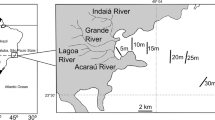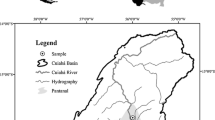Abstract
Littorina brevicula (Philippi) is an abundant herbivorous gastropod species inhabiting intertidal zones of the north-western Pacific and has internal fertilization with planktonic eggs and a larval stage. A population of L. brevicula on a shore in Amakusa, Japan, splits into an upper and a mid shore sub-population during the mating season in winter, while all individuals occurred in the upper zone in summer. Transplant and recapture experiments have shown that snails from each sub-population have a distinct pattern of seasonal migration, suggesting that the snail population consists of two behavioral morphs. To explore the relationship between migration pattern and life history characteristics in the snails of the two migration morphs, monthly quantitative samplings and a mark-release and recapture survey were carried out for the population of L. brevicula over a 1-year period. In autumn, some of the adults migrated downward to the mid shore and formed the lower sub-population from October to April. Migration between the upper and lower sub-populations was minimal from December to February, when L. brevicula copulate actively. The shell growth rates of the snails in the lower zone were slightly higher than those in the upper zone, but the shell width of females was not a good predictor of the number of mature ova they contained. The number of mature ova was not significantly different between the females of the two migration morphs. In addition, the mortality of marked snails did not differ significantly between the upper and lower zones. Thus, no evidence was obtained to indicate a difference in the reproductive fitness between the two migration morphs.







Similar content being viewed by others
References
Amio M (1963) A comparative embryology of marine gastropods, with ecological considerations. J Shimonoseki Univ Fish 12:15–358
Curtis LA (1987) Vertical distribution of an estuarine snail altered by a parasite. Science 235:1509–1511
Fretter V, Graham A (1994) British prosobranch molluscs. Ray Society, London
Johannesson K (2001) Parallel speciation: a key to sympatric divergence. Trends Ecol Evol 16:148–153
Johannesson K, Rolán-Alvarez E, Erlandsson J (1997) Growth rate differences between upper and lower shore ecotypes of the marine snail Littorina saxatilis (Olivi) (Gastropoda). Biol J Linn Soc 61:267–279
Kojima K (1959) The relation between seasonal migration and spawning of a periwinkle, Littorina brevicula (Philippi). Bull Biol Stn Asamushi 9:183–186
Magurran AE (1999) Population differentiation without speciation. In: Magurran AE, May RM (eds) Evolution of biological diversity. Oxford University Press, New York, pp 160–183
Ohgaki S (1981) Spawning activity in Nodilittorina exigua and Peasiella roepstorffiana (Littorinidae, Gastropoda). Publ Seto Mar Biol Lab Kyoto Univ 26:437–446
Ohtsuka S, Yoshioka E (1985) A preliminary note on the pelagic eggs of marine invertebrates. Spec Publ Mukaishima Mar Biol Stn 1985:225–235
Reid DG (1996) Systematics and evolution of Littorina. Ray Society, London
Roberts DJ, Hughes RN (1980) Growth and reproductive rates of Littorina rudis from three contrasted shores in North Wales, UK. Mar Biol 58:47–54
Skúlason S, Snorrason SS, Jónsson B (1999) Sympatric morphs, populations and speciation in freshwater fish with emphasis on arctic charr. In: Magurran AE, May RM (eds) Evolution of biological diversity. Oxford University Press, New York, pp 71–92
Son MH, Hong SY (1998) Reproduction of Littorina brevicula in Korean waters. Mar Ecol Prog Ser 172:215–223
Takada Y (1992) The migration and growth of Littorina brevicula on a boulder shore in Amakusa, Japan. In: Grahame J, Mill PJ, Reid DG (eds) Proceedings of the third international symposium on littorinid biology. pp 277–279
Takada Y (1995a) Seasonal migration promoting assortative mating in Littorina brevicula on a boulder shore in Japan. Hydrobiologia 309:151–159
Takada Y (1995b) Variation of growth rate with tidal level in the gastropod Monodonta labio on a boulder shore. Mar Ecol Prog Ser 117:103–110
Takada Y (2001) Comparison of the activity patterns of nine molluscan grazers on a boulder shore at Amakusa, Japan. Venus 60:157–172
Takada Y, Kikuchi T (1991) Seasonal and vertical variations of the boulder shore fauna in Amakusa. Publ Amakusa Mar Biol Lab Kyushu Univ 11:1–17
Takada Y, Rolán-Alvarez E (2000) Assortative mating between phenotypes of the intertidal snail Littorina brevicula: a putative case of incipient speciation? Ophelia 52:1–8
Underwood AJ (1979) The ecology of intertidal gastropods. Adv Mar Biol 16:111–210
Xue Q (1992) Study on population dynamics of Littorina brevicula on rocky shore in Qingdao, China (in Chinese with English abstract). Oceanol Limunol Sin 23:438–444
Zaslavskaya NI, Takada Y (1998) Allozyme variation and behavioural dimorphism among populations of Littorina brevicula (Philippi) from Japan. Hydrobiologia 378:53–57
Acknowledgements
I am grateful to Prof. T. Kikuchi for giving me the opportunity to study this subject. I also thank M. Tanaka, K. Mori, K. Nandakumar, and I. Yosho for valuable suggestions during the course of this study. Comments from S. Nishihama and S. Ohgaki improved the manuscript.
Author information
Authors and Affiliations
Corresponding author
Rights and permissions
About this article
Cite this article
Takada, Y. Dimorphic migration, growth, and fecundity in a seasonally split population of Littorina brevicula (Mollusca: Gastropoda) on a boulder shore. Popul Ecol 45, 141–148 (2003). https://doi.org/10.1007/s10144-003-0151-y
Received:
Accepted:
Published:
Issue Date:
DOI: https://doi.org/10.1007/s10144-003-0151-y




